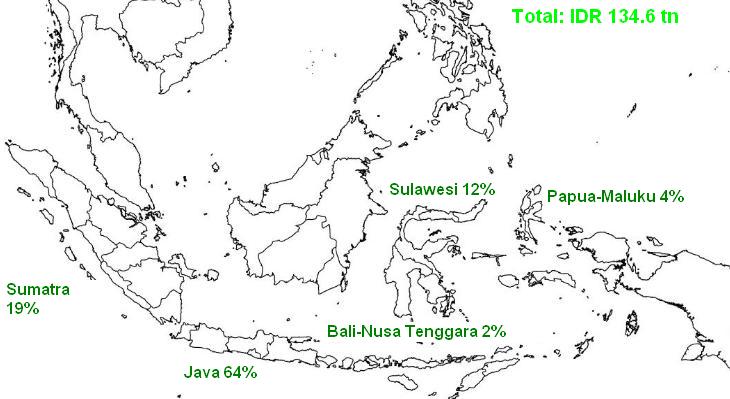Good news for the prospect of increased renewable energy development in Indonesia. In mid July the nation’s Ministry of Energy and Mineral Resources announced its desire for IDR 134.6 trillion (USD 15.7 billion) to fund renewable energy projects through 2025. Most, 64 percent, will go to the heavily populated region of Java. Specifically, its distribution will be IDR 25.06 trillion to Sumatra, IDR 86.3 trillion to Java, IDR 15.77 trillion to Sulawesi, IDR 2.64 trillion to Bali-Nusa Tenggara and IDR 4.83 trillion to Papua-Maluku (see map). Indonesia plans on raising the proportion of its energy generated through renewable sources from its current level of 5 percent to 17 percent—up from the previously set 15 percent—over the next 15 years.
In addition to creating new power plants and the supporting infrastructure, the Indonesian government will also target small-scale generation—specifically solar. Street lamps will be upgraded to solar cell lamps and taken off of the grid. Shopping centers in major cities will also be encouraged to install solar panels on their rooftops.
Biomass too will receive funding. Explicitly targeted for development is the use of palm oil shells and jatropha, since these potential fuel sources are inedible and thus do not directly compete with the food industry.
The multi-billion dollar financing will give a substantial boost to the prospect of clean energy to the world’s fourth largest populace, despite the country’s relative abundance of fossil fuels. Power generation is one of Indonesia’s greatest obstacles for economic development, as the nation ranks near the bottom in terms of per capita consumption of electricity—well below the world average, and even behind countries such as Zambia and Honduras.
To help solve this problem, Indonesia’s renewable energy production such as wood pellets production, may double by 2025 from its current level of just over 7 gigawatts. Biomass—mostly as liquid fuels—may account for around a third of this, complementing hydro, geothermal and solar sources. This would entail a significant expansion to the nation’s present 1.7 gigawatts of biomass power production, largely generated by the palm oil and sugar industries.
Whether from generated from biomass, hydro or solar sources, the announcement by the Ministry of Energy and Mineral Resources is reason to expect more good news from Indonesia’s renewable energy sector in the years to come.

